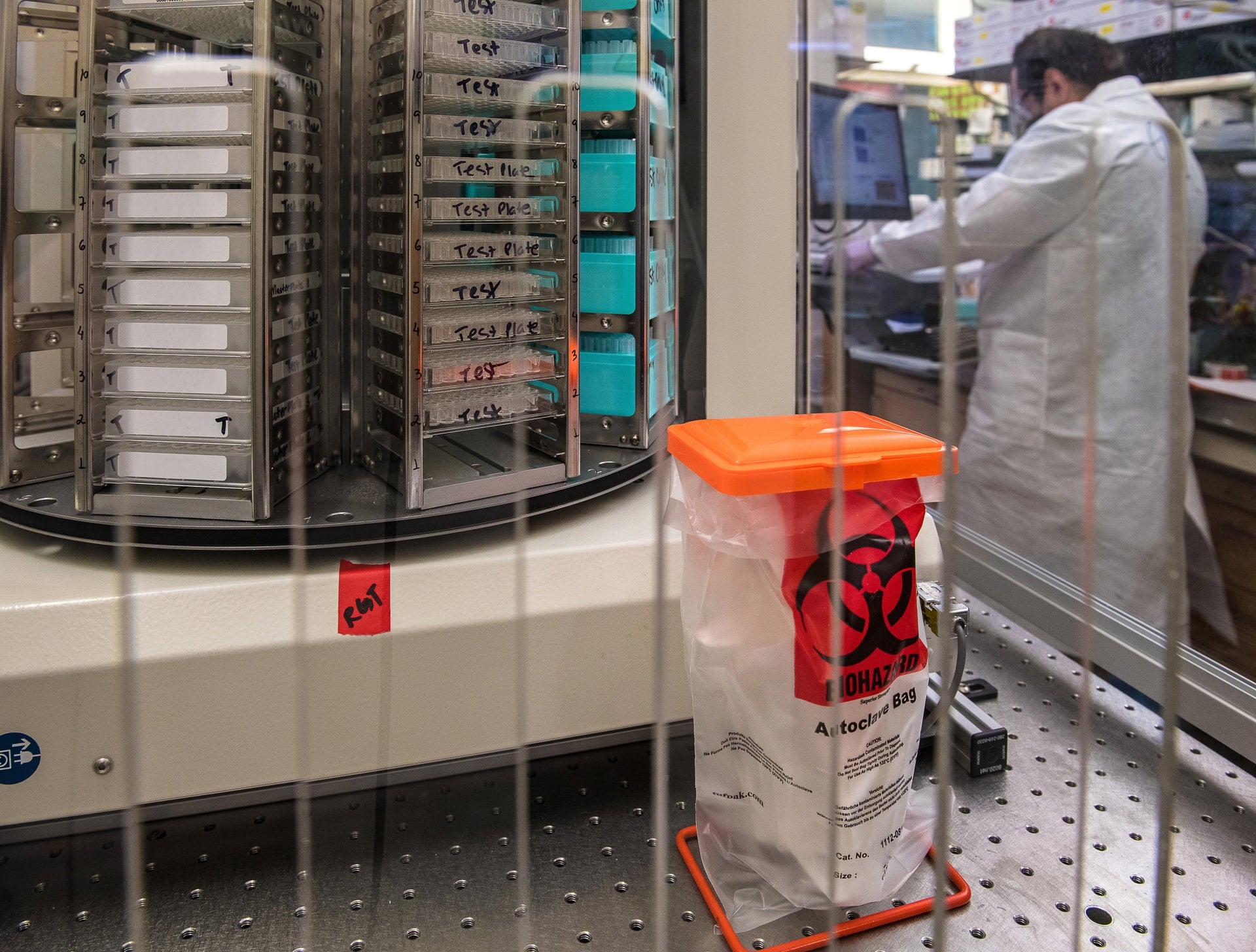Watch the Webinar 'Simplifying Production with Drag and Drop Scheduling for Your SAP System' with Just Plan It
Learn more about Production Scheduling for SAP ERP. Have questions? Contact us.
[Transcript]
Welcome to Navigator Business Solutions, monthly customer experience webinar. Today's webinar is Just Plan It, a planning and scheduling tool for SAP. Couple quick housekeeping items in order to cut down on background noise and the dreaded goto webinar echo, everyone will be placed on mute. You will however have the ability to enter any questions you have via the questions box on the goto webinar pop out menu. So hopefully you all see that so you can just log your questions there. Everybody's gonna be on mute, as I said. So log your questions there as we go through, we're gonna table all the questions till the end to make sure that Dave can get through the entire presentation and then we will read out the questions and he can answer them as needed. So with that, we're very excited to welcome Just Plan It and Dave. And so I will turn it over to you at this point, Dave, thank you everyone.
All right. Thank you very much. Nice to meet everybody online here. And what I'm gonna start off with just to kind of set the field is I'm gonna go through a little bit about the company and a little bit about the software, and then I'm gonna go into the software and show you the tool. So if you look at Just Plan It and just plan it as a product that has been developed by Medtronics and they're based outta Germany, 40 plus years of involvement in this environment. And of course strong and number of users are significant thousands of customers using our software. And of course our recent one working with SAP by design with Just Plan It. And so we have a lot of success there too as well. So what we're trying to do is help you become more profitable and give you visibility while doing that.
And also real time priorities. And of course, if we do all this well, we're going to make sure that your on time delivery performance gets better at the same time, maximizing the throughput characteristics of your company and, and utilizing your capacity to the best of our abilities. And of course adding some flavor to this too, is because what we do wanna get is information as we proceed to give us information about the, you know, the As built condition of jobs that are production orders that are flowing through, we wanna make sure that we're continuously improving our company too, as well. So let's talk about this life cycle about JP and life cycle with SAP BydDesign. So of course, we've got the kernel of Just Plan It and its scheduling engine and the execution side of things as well.
There's a smart interface between the two software products. You have two options in this case. One is it could be an automatic thing that happens in the background, a smart interface that's configured to your characteristics. The other way we can do this, we can actually show you via a tool to show you the list of jobs that you'd want or production orders. You'd like to move over and update Just Plan It that information goes through the scheduling tool and we actually get as built or as required changes taking place. And we might see some deviations that take place. So what we want to do is take that information and determine whether or not it's a hiccup or whether we go back and update that and in the system of record, which is by design. So that is this continuous loop that takes place.
So some things are automatic and be a do it kind of thing, approach. So if we are seeing some activity that warrants change, we should make sure that that takes place. So we get a better schedule. So the way it looks like this is there's a, here's a plan. I'm gonna go into software in a moment here too, as well. Here's a plan for this week, let's say for instance. So June 6th in the course, it's a little bit off schedule for that, but it's showing you the active current jobs that are coming from SAP into our tool in providing you with an automatic schedule. All right. So as activities take place on the shop floor, and I get feedback from SAP ByDesign it will actually update the schedule too as well. So you'll see now in this case, it going from where I was before, which is showing a lot of blue in here in some, the current jobs being planned.
And if I go to this step here, you'll see now the colors have changed. So the things on the left of the planning start date are black in color. The colors are up to you by the way, and I'll show you that one again in the software, but it's showing you what has been completed. All right. And things that have not been completed are in the green ones right there. And they're actively being worked on right now. And of course the schedule gets updated in real time. If you will, to give you information and it provides this information fromJust Plan It back into SAP to give you dates that may be necessary to run the MRP characteristics of your system. OK. So I'm gonna go ahead and escape out of this and get into the software.
All right. So this is the active tool itself, and I'm gonna stay in this tab right here. And by the way, this is a browser based system. I'm using Chrome right here. So, you know, right now what I've chosen is this understand and schedule area right now. So this is a visual based system. All right. So it's visually showing you, it's actually visual scheduling tool. So it's giving and providing you information in real time, in a graphical way in colors there, or in characteristics that are gonna make sense to you. So now in this case here, my jobs, I'm in my job centric view, and this job over here, this icon here, it shows me the the actual departmental view, my machines, my lines, my people, and how jobs are currently being scheduled to each one of those. And of course, then I can go to this next step.
Here is then look at my individual characteristics. So I can look at just a specific machine or if I can look at a specific person in here too, as well. Now I'll go back to those in a moment. I'm just gonna to kind of show you some of the building blocks that take place here. So the information that's in here right now is actually coming from the ByDesign or SAP by Business One can come in here too as well. And in fact, what'll happen is the data that's gonna come in here is gonna look like this. So if I click on any one of these here too, I'm just gonna click on this job here. You notice that when I it's smart, too. So I just clicked on this job. It moved it to me closest to me in the schedule here. And if I click on this down arrow, it shows the actual operations or tasks that are gonna be necessary to do that in the estimated time that we have to do each one of those too, as well.
So that's information that shows you the job and how it's actually come together in the operation steps and the operation steps can be very, very complex including steps like engineering or any other process steps that may not be your typical routing steps that you may have. So I have you also noticed here that I have numbers on the left hand side. So that is a prioritization of all the jobs that are coming in here. So if I have jobs coming in here, how I prioritize is up to you, it could be date driven. It could be your most important customer, whatever is the way that you prefer to prioritize. You can do that in here. And in fact, if you notice this job right here, this job number right here, this production order number 32671 right now is showing a one in front of it.
That's actually a one day late. So, and of course you see some other ones down here too, as well. Up above here, it's showing you some KPIs. Now I'm gonna try, I'm gonna show you something here. So let's say we decided that this customer is, is, is important, very important to us, and we wanna make sure that they get their order on time. You can come in here and say, now it's currently the number eight priority. I can come in here and ask it what it would take to make it on time. Right now it's saying it, make it a number six. And by the way, that'll reduce the number of hours. And for this job, it'll take it from number 11 to number 8 down here as well. And so the it's a good news is this is a good decision to make.
So we go over here and say six to this and say that too, as well. And what happens is now that data is rescheduling. And by the way, what we're showing here is a real time schedule that just took place. So this is gonna provide you information to make good decisions on to of that. It actually make,uless jobs late. That's what it's showing you over here. It's showing you that my revenue stayed the same. If you are showing revenue, that's something we can do as well. It also reduced my buffer time and throughput time was, was better too as well. So that decision was a good decision for us to do, but if I didn't wanna keep that decision, I can just say, okay, let's undo that. So you can undo anything you've done in here and actually provide you with a new schedule and you see that it updates the schedule.
And again, what I've been showing you here is real time. And so it's updating the schedule as we see this. So, and actually providing you with visual feedback as to what changes took place and give you some decision making criteria. So now if you look at over here now I'm in the group view. And if I've got my machines here and I've got people, so when, if I click on any one of these tasks over here, like this one here, you notice there's dotted lines. So it's saying, I need this machine to do this particular job or task. If you will. And down below here, it's saying, I need a person in this case. It's Sue. Now you notice that Sue and John right here have not only in here, this is a finite scheduling system, but what it's doing is it's showing you that Susan and John have multiple jobs scheduled at the same time.
That's an option in our system to use that. And it allows you to have somebody set up a machine, possibly go off and set up another machine and let it run. So I have two machines that are monitoring, and that's really up to you as to how many machines people can run or, or monitor in that case. So that's what those dotted lies are showing you. So it's actually doing that for you now, another nice thing about a tool like this is I can manipulate and change the schedule. What I mean by that is this, let's say that I wanna move this machine to this machine. Okay. Or this, this and that machine to this machine. It's a matter of just dragging and dropping. And now of course what's happening also, is it rescheduled everything too as well? So if I undo that again, I can do that. I'm gonna make another change too. I'm gonna actually do something a little different and I'm gonna cause an issue with the revenue for the month too, as well.
There're a bit here for it happened there. We're going a little bit slow here for some reason, maybe cuz we're on the internet with a lot of things going on right now. Okay. So I'm gonna go back and change my view to, to this view. So execute view and, and, and we'll have the colors now. So now if I were to change this, let's say I wanna move this one out. For whatever reason I wanna move it to Monday. All right. Now what happens is that's gonna move that out for me there. And it'll provide me again with an updated schedule based on that. So I've manually updated that to take place. And I did that on my own and it'll actually drop that in for me here.
But it did that for me there. So it moved it out there and it made it red. And of course now I've got the KPIs being updated here too as well. And it's showing that I'm, I'm running one more job late than I did before. All right. Again, I can undo that as well. So you notice also what took place. So you see a lot of this information here, like for instance, this job right here is got this lines going down right over here to this job right here. Now you notice what's happening here is that there's a link. So these are predecessor successors. So in fact, if one particular portion of that, of these connections here were to move out, let's say, move it out to here.
It'll effectively move out the predecesor successor, the successor job as well. So you noticed it did that. So I have a parent child relationship happening there too as well, undo that. So a number of other features in the system too, as well, that can be handy for you. And that is if I wanted to just take another view of this too. So if I have situations where I'd like to have like products follow each other, so I'm gonna change this to this view right here and what it's basically showing you right now, and I'm gonna zoom in here, by the way, you can zoom in and out to show you your current backlog all the way out, as far as it goes out there in months, years, and there too as well. So I'm gonna go in here. You noticed that I've got these two products right here.
I've got two that are in blue. That's saying that they're the same basic changeover requirements. So I could save time by putting them closer together or worked after each other. So I'm gonna just drag that to that. And what happens is, again, I'm rescheduling that it's actually moving that job into there. And of course it's following this job now too as well. Again, it didn't affect me in any way. Okay. I've actually got one job less time now. So we're in good shape that way. But outside of that, everything's going very well first now. I'm gonna take one step further here. I'm gonna actually log off of this account and I'm gonna log into another account because I wanna show you the activities that are gonna take place when I get feedback from ByDesign. So I'm gonna go back in here and it's gonna show you that same information that we've been manipulating and changing, but it's gonna act effectively show you what has happened during the process of a week all and that's been, but of course that's gonna be happening in real time.
Have we pulled that information from ByDesign and I'm switch this over to shop floor view, and we'll have that there. And you'll see now I have all those updated. So now it's currently showing you, all of these jobs have been completed. These are in, these are currently in process. The green ones, the black ones have completed as I go forward. You can see my schedules been updated. So I get an information that's coming from ByDesign, but updating our schedule here inside of Just Plan It . Okay. So I'm gonna log out of that and go back in.
All right. Again, you're seeing how we actually do log into our system too as well. So I'm gonna switch over to this one count. Okay. So I think what I've done I've actually gone through the areas that I wanted to go through today. Hopefully this showed you more information about our tool and hopefully help you have a better understanding of what may be helpful for you as well. I'm gonna zoom in here again. I'm still in the, I'm gonna change it back here. I'm open it up for questions. Now, if anybody's got any questions, please feel free to ask them.
So one of the ones was that they wanted, one of the participants wanted to confirm that this visual scheduling will work equally as well for SAP Business ByDesign as well as SAP business one. That's correct. Isn't it?
Yes, it is. I, I, I kind of hit that a little bit during the beginning part of it, but yes, it is true. We can work with either one and this data is transferred. Of course the system of record stays in place at, at whatever E R P you're using there. And then of course the information will be updated to as well.
And then to confirm is this a separate add-on to the SAP cloud ERP? And I could answer that one. Yes, it is.And it will any updates to the dates in this system automatically change the dates and ByDesign.
If you'd like them to they do. And in fact what you'll see is any job and any, any task, if you will too, as well as, and if I hover over any of this information, it shows you when I'm gonna start it. But when I expect to finish it, you'll see that in the start and end date, that end date is the date that we would send back to SAP so that you could actually run your MRP and get effectively what your demand supply and demand pictures organized better for you. So, yes.
Great. Are there any other questions from our attendees? It looks like that covers the questions at the moment, Dave. If you wanted to go over that quick outline of your implementation outline.
So let's switch over here now and go back to presenting here. All right. This one. Sorry about that. And change quick.
Follow up questions here. If we change the order in the planning board, will it update SAP?
Yes, exactly. It's we, we are primarily going to always anything that is, is needed to be updated SAP. We wanna make sure it takes place. So the system of record has that. So, yes.
And then a more detailed question. How is data collected from the plant floor? So
I assume that you're doing that with an SAP. If not, we have a tool to do that too as well.
So we can update that so I can, I'll go back to matter of fact, let me just kind of quickly show you that tool. Cuz we do have an execution module in our system too as well. So if you're not doing it within SAP, you could potentially do it in here too as well. In fact, we've got a client approach for the operator on the shop floor that is this right here that I'm showing you right now is the execution part of our software where we can say something has been started or completed here or any other characteristics about that. But if you're also, if you're an operator on the shop floor, you may not wanna look at a tool like this. You may wanna look at more as something that's more simplified and it could provide you a list of work that is necessary for you to do that day. And it'll give you that in a list it's only formatted to you. So for you log in, if you're on a phone or a tablet would show you only the work that is necessary for you to work on, of course it make, I can start it now. Now just like you would expect
Interesting, yeah. Can you change, can you, can you send your suggested changes to a supervisor for approval?
Oops answer is yes. Yeah. We have a, we have, we call a, a supervisor view too as well. So that exactly happens so that I can, they can change and alter and update if necessary, before it actually gets pushed in. Yes. Yep. And then we call it a, we call it a chief view, so yeah. Yep.
Are you able to do infinite scheduling, like overlapping batches?
Yeah. you can let me go back into the software. So let's go back to any this particular view. So now in fact, I've got some examples in this demonstration database that I have right now. So if I click on here, if I look down here a little bit further zoom out a little bit and if you look down here, let me change this back to execute and down below, I've got some other example work and you'll notice that in this case here I'm outsourcing some work. So the resources themselves are, can be either finite or infinite. In this case here, my outsourcing is infinite because all I'm really worried about is the fact that it's going out of our facility at some point in time when it's supposed to go out and it's gonna come back on another day or time as well.
So that would show how it's stacking here in this case. So you can actually do that with any resource. You could make any resource finite or infinite just by actually clicking over here and edit them. And by the way, you can also put calendar information in here as their availability, but you can make them infinite or finite too as well. It'll reschedule and allow the overlapping if you will. But you can also put calendar exceptions in here as to when things are not available. In fact, I'm glad that you asked that question because I forgot to do that as part of this. Let's say this say line four here was gonna be down for a period of time. You could come in here and do a calendar exception and just say, okay, for the, maybe the seventh through the, the ninth.
And let's say there's no time involved. Let do this right here. So the seventh through the ninth, and I'm gonna put in no time in here and I'm gonna say the machine is down for maintenance. All right. Just say, okay to that what'll happen is you'll see that it'll put in that as time that can't be scheduled and that's it right there. Matter of fact, I can shows you in a color that's based up, it's up to you to do, and you see it rescheduled everything based on that too, as well. So thank you for asking that question. Got more to that I forgot to put in there. So thank you.
All right. Implementation or getting you folks live and operational. Let's take a look at that. So what we do is we make sure that you're successful. So we have what within called JPI launch. And what we do is we take in and provide you with some tools. First of all, there's a video academy that's included in that. So you get training online with our software. You also get an expert that helps you through this process to make sure you don't make some little decisions that may be not what you wanted to have in the end. All right. So we make sure you're a hundred percent successful through that and training.
And here's what the process looks like if you will. And it's pretty simple. We actually take the resources. We actually pull them right from SAP. So the resource criteria comes in there, availability of those resources and then some information about possibly some some recurring type templates. And that could be used as well. We go live and operational, and of course this all happens very quickly, typically anywhere between two to four weeks, we're fully operational here's the video academy. And in fact it actually is online takes you through this. It's about total of about eight hours of training. It provides you with information and, and actually walks you through exercises that you will take in little snippets six minutes, eight minutes and 12 minutes kind of thing. And you'll do that. And you go back into do that process and then come back and take the next part of the class as well
What's the approximate time for implementation
Anywhere between two to four weeks.
Depend I obviously, depending on the data and the structure of schedule,
Right?
So I, a follow up question. Does the system send out like daily reminders if a project's been moved out and that it's going to impact other schedules, does it send out a notification?
It does. We actually have a, a messaging system built into our software too as well? So yes, within our tool, there is a messaging system as well. And in fact, it'll, it'll provide you with emails to statuses of jobs. And of course, if everything's going fine, I don't really need to get the notice on it, but if something's going wrong, something's approved to be late. It'll actually send you off a message in your email.
Great.
And that's what this messaging system is about right here.
Fantastic. Okay, Dave, with that, doesn't look like we have any more questions at this time. So with that, I'm gonna say Navigator, thank you very much for everyone for attending Dave. Thank you very much for walking us through Just Plan It and the visual scheduling.
You're welcome. Thank you.






